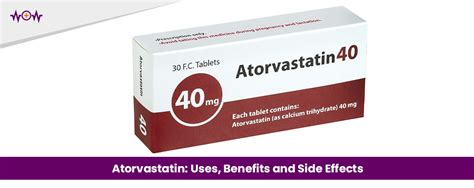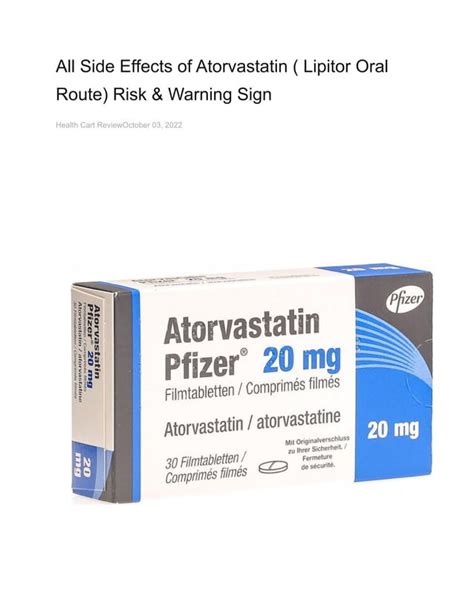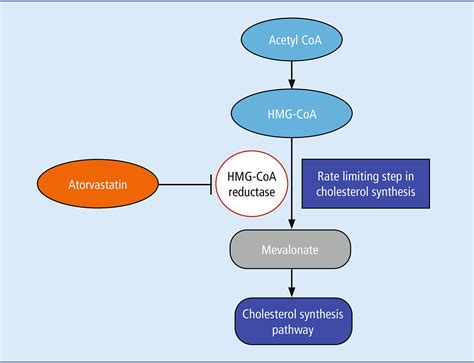Intro
Discover key Atorvastatin facts, including its role in cholesterol reduction, statin benefits, and potential side effects, to understand this lipid-lowering medications impact on heart health and cardiovascular disease prevention.
The world of pharmaceuticals is vast and complex, with numerous medications available to treat a wide range of health conditions. One such medication that has gained significant attention in recent years is Atorvastatin, a statin used to lower cholesterol levels and prevent cardiovascular disease. With its widespread use, it's essential to understand the facts surrounding this medication, including its benefits, side effects, and usage guidelines. In this article, we'll delve into the world of Atorvastatin, exploring its history, mechanism of action, and practical applications.
Atorvastatin has been a cornerstone in the treatment of hypercholesterolemia, a condition characterized by elevated levels of low-density lipoprotein (LDL) cholesterol, also known as "bad" cholesterol. By inhibiting the production of cholesterol in the liver, Atorvastatin helps reduce the risk of heart attacks, strokes, and other cardiovascular events. Its effectiveness has made it one of the most prescribed medications globally, with millions of people relying on it to manage their cholesterol levels.
The importance of understanding Atorvastatin cannot be overstated, as it has a significant impact on public health. With cardiovascular disease being a leading cause of death worldwide, medications like Atorvastatin play a crucial role in preventing and managing these conditions. By exploring the facts surrounding Atorvastatin, we can gain a deeper understanding of its benefits, potential side effects, and how it can be used effectively to improve overall health and wellbeing.
Introduction to Atorvastatin

History of Atorvastatin
Atorvastatin was first approved by the US Food and Drug Administration (FDA) in 1996 and has since become one of the most widely prescribed medications globally. Its development was a significant milestone in the treatment of hypercholesterolemia, offering a new and effective way to manage cholesterol levels. Over the years, numerous studies have demonstrated the efficacy and safety of Atorvastatin, solidifying its position as a cornerstone in the treatment of cardiovascular disease.Benefits of Atorvastatin

Working Mechanism of Atorvastatin
Atorvastatin works by inhibiting the enzyme HMG-CoA reductase, which is responsible for converting HMG-CoA into mevalonate, a precursor to cholesterol. By blocking this enzyme, Atorvastatin reduces the amount of cholesterol produced in the liver, leading to lower levels of LDL cholesterol in the blood. This, in turn, helps prevent the buildup of plaque in the arteries, reducing the risk of cardiovascular disease.Side Effects of Atorvastatin

Usage Guidelines for Atorvastatin
To minimize the risk of side effects and maximize the benefits of Atorvastatin, it's essential to follow the recommended usage guidelines. These include: * Taking the medication as directed by your doctor * Monitoring your cholesterol levels regularly * Maintaining a healthy diet and exercise routine * Avoiding grapefruit and grapefruit juice, which can interact with Atorvastatin * Reporting any side effects to your doctor promptlyPractical Applications of Atorvastatin

Statistical Data on Atorvastatin
Numerous studies have demonstrated the efficacy and safety of Atorvastatin, with statistical data showing: * A 30-40% reduction in LDL cholesterol levels * A 20-30% reduction in the risk of heart attacks and strokes * A 10-20% reduction in the risk of cardiovascular mortality * A significant improvement in overall cardiovascular healthConclusion and Future Directions

Final Thoughts
As we move forward, it's essential to continue monitoring the effects of Atorvastatin and exploring new ways to improve its efficacy and safety. By doing so, we can ensure that this medication remains a valuable tool in the treatment of cardiovascular disease, improving the lives of millions of people worldwide.What is Atorvastatin used for?
+Atorvastatin is used to lower cholesterol levels and prevent cardiovascular disease.
How does Atorvastatin work?
+Atorvastatin works by inhibiting the enzyme HMG-CoA reductase, which is responsible for converting HMG-CoA into mevalonate, a precursor to cholesterol.
What are the benefits of Atorvastatin?
+The benefits of Atorvastatin include reduced risk of heart attacks and strokes, lowered levels of LDL cholesterol, and improved overall cardiovascular health.
What are the side effects of Atorvastatin?
+The side effects of Atorvastatin include muscle pain and weakness, liver damage, increased risk of diabetes, cognitive impairment, and digestive issues.
How should I take Atorvastatin?
+Atorvastatin should be taken as directed by your doctor, with regular monitoring of cholesterol levels and maintenance of a healthy diet and exercise routine.
We hope this article has provided you with a comprehensive understanding of Atorvastatin and its role in managing hypercholesterolemia and preventing cardiovascular disease. If you have any further questions or would like to share your experiences with Atorvastatin, please don't hesitate to comment below. Additionally, if you found this article informative, please share it with others who may benefit from this information.
